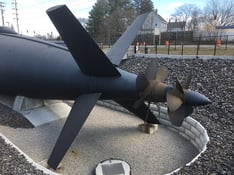
The Columbia-class submarine now under construction by GDEB, will be the most advanced SSBN in the world and the largest submarine ever built by the United States. The SSBN classification is the US Navy acronym for a Submarine armed with Ballistic missiles, that is Nuclear-powered. The SSBNs have a different primary function than SSN fast attack submarines, and need different design features as well. As part of America's Nuclear Triad, an SSBN’s mission is to keep its position a secret, while serving as a strategic ballistic missile platform. Compare that to an SSN’s mission of actively seeking out and engaging all enemy targets in a wide range of environments. One of the interesting design changes made to the Columbia-class, is the switch to an “X-Stern” configuration of rudder/planes, from the existing “cross-shape” design now seen on Ohio-class SSBNs and Virginia-class SSN boats. Why did the US Navy decide to move to an X-shaped stern control plane design?
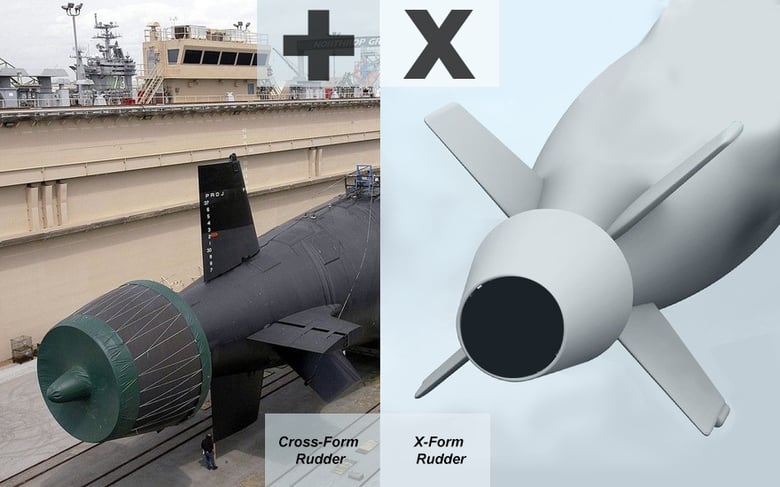
Rudders and Planes
Firstly, as you may know most submarines have two basic ways to control their movements underwater. Like a surface ship, a sub uses its engines to create forward movement, and a Rudder to steer from side-to-side (yaw). To control its up and down movement (pitch), a sub traditionally uses two sets of diving planes, in addition to a variety of ballast tanks which control buoyancy. One set of diving planes are positioned in the back (stern) of a sub, and the other towards the front (bow). If the planes located on the bow are attached to the sides of the sub they are simply called Bow planes, if attached to the sail, they’re called Sail planes (or Fairwater planes).
The stern planes are used for major course control to set the pitch of the boat either up or down. If you need to dive deep underwater fast- flood the ballast tanks and use the stern planes to point the front of the sub downwards. The Sail or Bow planes are used to allow a ship to gently rise or sink to an exact depth, while keeping the sub level. If you wanted to slowly raise your periscope above the surface of the water - use the Bow planes.
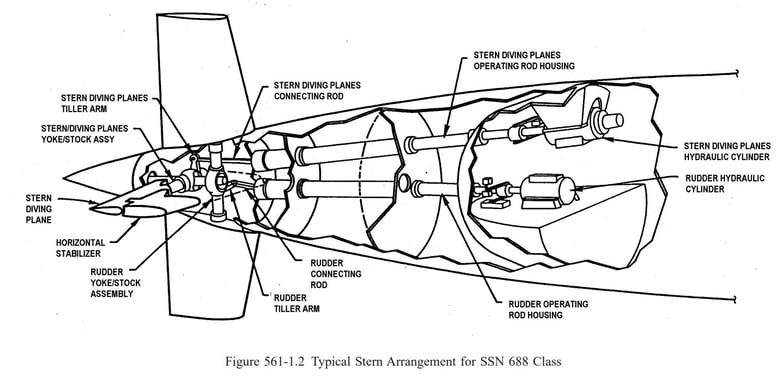
The “Cross” and “Ex” Design Forms
In the common “cross-shape” or cruciform design, the stern rudders are vertical and the diving planes are horizontal (see above illustration). The rudders are often linked together by a yoke, so they can both turn at the same time. Due to this yoking, each pair of rudders can be controlled by a single operating rod. The diving planes can also be joined by a single yoke or controlled separately for greater maneuverability.
In a basic cruciform plane design, the control system makes the rudder operating rod extend or retract, causing the ship to turn. Likewise, to dive or surface the diving operating rod extends or retracts. In other words, in some submarines only two rods control all directional movement.
An X-shaped stern control surface (hydroplane) design is more complex and uses four rods that interact with each other. There are no longer rudders just for yaw, but rather four planes controlling yaw and pitch at the same time. Each plane has a separate operating control, and any change of direction uses all four rods moving in harmony.
Having four controllers is obviously a much more complex design than just one, which is part of the reason this system was seldom used in the past. In fact, the last US Navy submarine to use an X-Stern design was the experimental USS Albacore in the 1960’s. Today however, computers can easily make the proper calculations via a joystick, and the human controller doesn’t have to worry about what each individual plane is doing. The UK Royal Navy will also be adopting the X-planes on their new Dreadnought-Class SSBN design, and will share the common missile compartment (CMC) “quad-pack” concept with the Columbia-class as well. The Chinese Navy (PLAN) is reportedly also moving to X-Form rudders for its new Type-039A-C Yuan class.
Note that in the GDEB image of the stern section (below), there is an offset axis of the X-rudder planes, with alternating rudders slightly more forward. While there's no official statement regarding this design choice, it might have been made to allow the option of having opposite rudders linked together by a yoke, allowing them to both turn at the same time. If true, this would provide the sub with a unique hybrid 4-Rod or 2-Rod control option.
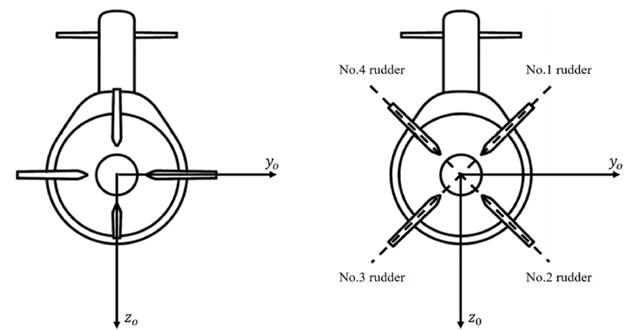
Note the offset axis of the X-rudder planes, with alternating rudders slightly more forward.
GDEB image of the stern section of the USS District of Columbia (SSBN-826).
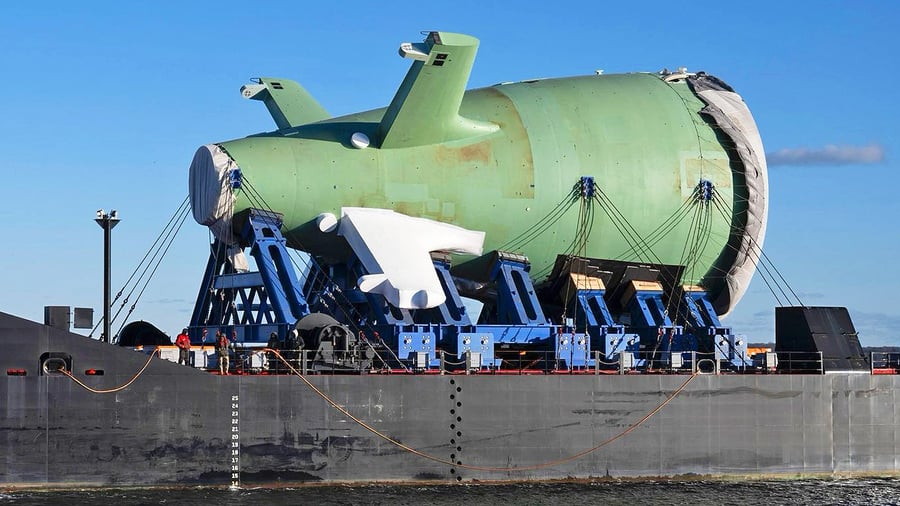
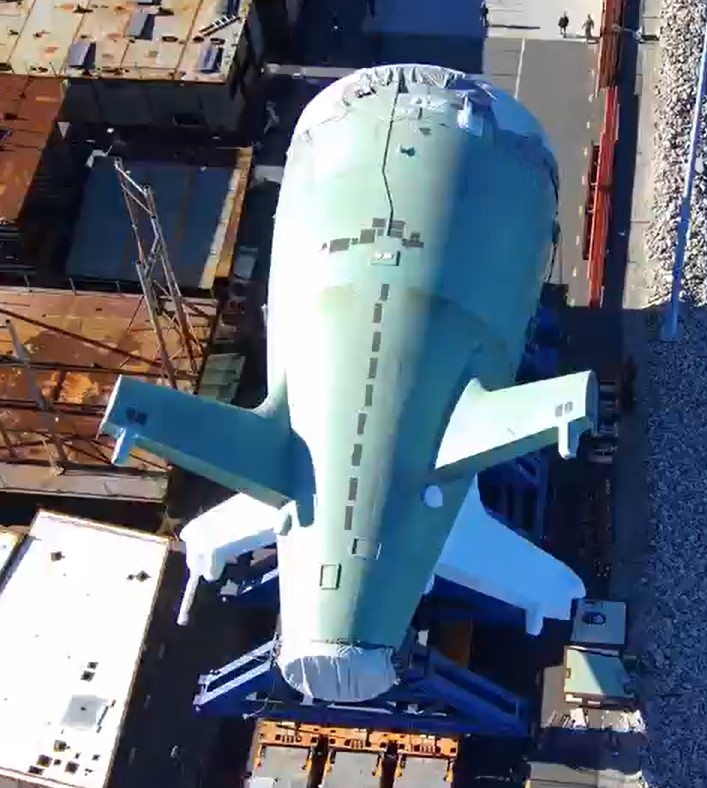
The Columbia-class was ultimately designed using the X-Stern configuration for several reasons.
- Maneuverability
As noted, in the X configuration (unlike cruciform designs), all four planes are used as part of any maneuver. Therefore, an X-Stern design has more maneuvering force per unit of control surface area than older cross designs. This allows the controls to be smaller, reducing the resultant drag. A Navy official confirmed that “the X-shaped stern will restore maneuverability to submarines; as submarine designs progressed from using a propeller to using a propulsor to improve quieting, submarines lost some surface maneuverability.” - Safety
GDEB notes that an "X-Stern configuration reduces the chance of an accidental dive, allowing for faster speeds at lower depths." In the older cruciform design systems, if the stern planes lost hydraulic power, the weight of the yoked planes could cause the planes to re-position, causing a “stern plane jam”, and send a sub into a full dive. At higher speeds, a sudden uncontrollable dive could send a submarine to below crush depth. It is theorized that the loss of the USS Thresher possibly involved a stern plane jam. The X-Stern may also reduce other issues, such as a rudder-induced “snap roll”, where a large heeling angle could cause the rudder to act as a diving stern plane, making a sub travel on a descending corkscrew path. - Reduced Noise Signature
The X-form of the planes also reduces the negative interaction between the propulsor and rudders. In fact the X-configuration actually assists in rotating the inflow of water to the propulsor, which homogenizes the wake flow field and further increases the propulsor's efficiency. These improved flow characteristics in turn helps reduce the overall noise signature of the submarine. For ships in the "Silent Service", avoiding detection is a key factor in their survival. If a submarine cannot be seen or heard, then it can’t be found, attacked and destroyed. - Improved Physical Layout
It has also been noted that the "X-Tail" design means that there is not a vertical rudder protruding above and below the submarine, which might have additional physical benefits. For example, not having a long rudder below the sub minimizes the chance of it hitting the sea bottom. Conversely not having a rudder above the centerline of the sub may allow easier access to the sub by AUVs or SDVs (Swimmer Delivery Vehicles) entering or exiting the sub's dry deck shelter (DDS).
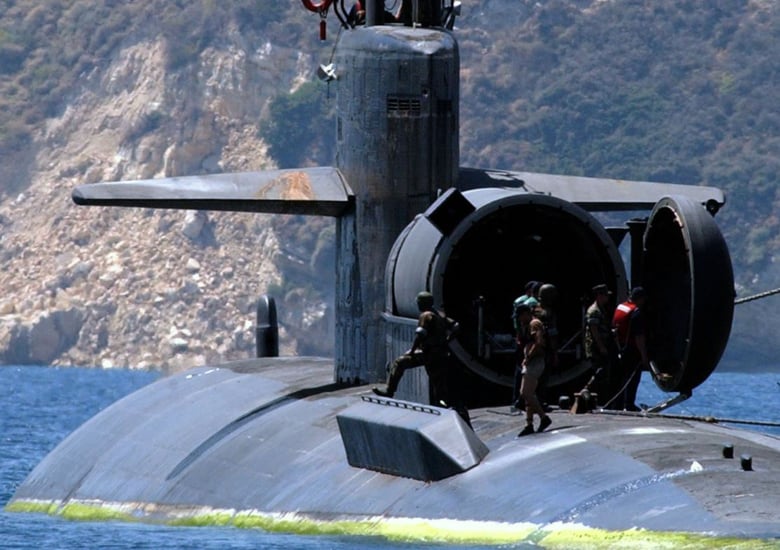
It’s worth noting that the Columbia-Class has also been designed to use Fairwater planes, instead of Bow planes. This might be due to its role as an SSBN ballistic missile sub and not an SSN attack sub. Attack subs such as the Virginia-Class tend to use Bow planes, possibly because Sail planes can cause issues with control when a sub is at periscope depth, and especially when surfacing in rough seas with high waves. Not having Sail planes also makes it easier to use their sail to break through heavy ice.
Current Ohio-Class SSBNs use Sail planes. These subs will disappear deep into the ocean for months at a time to remain hidden from detection, so maintaining an exact position near the surface is not a priority. In addition, having Bow planes causes extra noise for their bow listening systems. As the ability to “hear” their environment helps them be the ultimate underwater hunters, having Fairwater planes way up on the sail is the best choice for these Ohio-class Replacement Program (ORP) submarines.
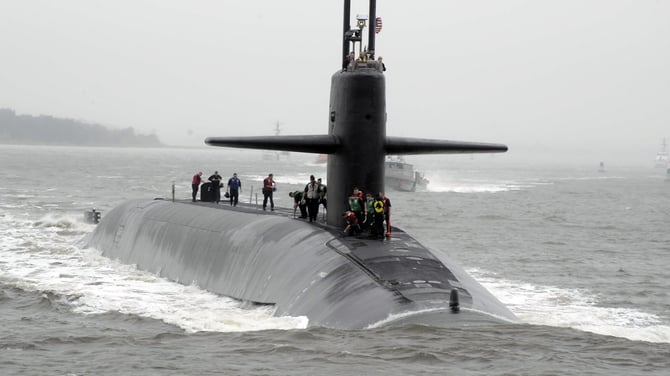
USS Alaska (SSBN-732)
The Navy has designed the Columbia-class to be fitted with the most "up-to-date capabilities and stealth" to ensure they are survivable throughout their full 40-year life span, and remain ready, if necessary, for the precise delivery of nuclear warheads. In addition to improved control systems, the new SSBNs will have other cutting-edge features including: the latest pump-jet propulsor technology, a nuclear electric drive system, a super quiet reactor core, a new and improved sonar array, as well as an advanced special hull treatment. They are a worthy replacement for the current Ohio-class SSBN "boomers". If you define having an “X-Factor” as possessing a noteworthy special talent or quality, then the Columbia-class is certainly a winner.
Globe Composite Solutions for Defense, Submersible, and Marine Use
Since 1997, Globe Composite has been designing composite submarine parts and has manufactured a wide variety of components to reduce the acoustic signature of U.S. Navy submarines as well as Acoustic Intercept Domes that increase their capability to detect potential adversaries. Globe also offers extensive submersible buoyancy solutions, and manufactures a variety of high-strength gaskets for submarine missile hatches and other critical components. Switching to composite parts lowers noise levels in many applications, as well as providing corrosion resistance and greater durability than metal, plastic, or rubber parts.
If your metal, plastic, or rubber parts fail, causing you time-consuming and costly problems, contact Globe Composite Solutions. Globe's team of designers, engineers, and chemists will assess your needs, quickly design replacement parts to radically improve performance, and allow you to more effectively accomplish your mission.


